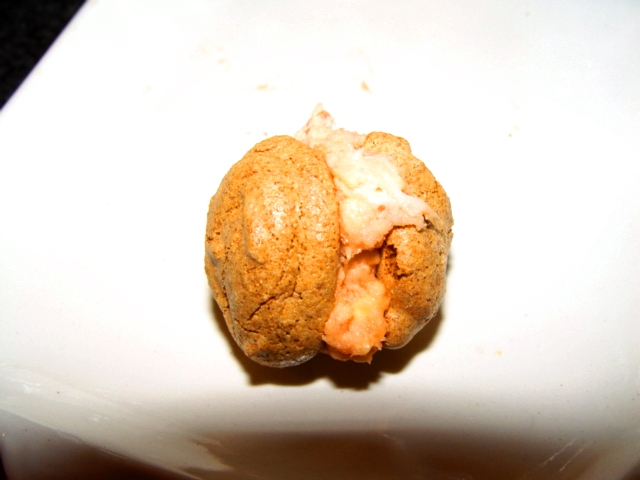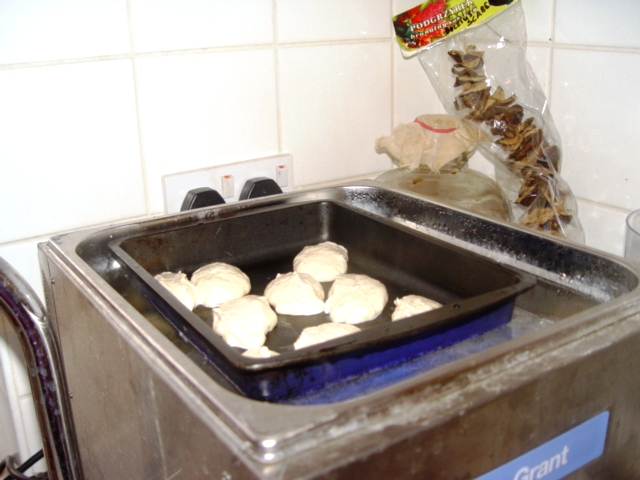
jackal10
-
Posts
5,115 -
Joined
-
Last visited
Content Type
Profiles
Forums
Store
Help Articles
Posts posted by jackal10
-
-
Abra: here is my take: http://forums.egullet.org/index.php?showtopic=121201

You could substitute an exotic sugar, like maltodextrin for the actual sugar I guess...
Have you considered a version of prawn crackers? http://forums.egullet.org/index.php?showtopic=63405

-
Savoury macaroons
-
In classical cuisine "Diane" usually referred to some connection with hunting, after the goddess Diana, the huntress
Thus Sauce Diane orginally served with venison (Poivrade- pepper with cream), but served with steak to give steak Diane
Dishes with game forcemeat are a la Diane (eg canapes, or eggs a la Diane are soft poached eggs with a game puree on toast), or Potage a la Diane is a game , lentil and cream soup
Dishes with Sauce Chasseur can also be described as Diane
Quails a la Diane are simmered in stock, served with tomato demi-glace, garnished with quenelle and braised lettuce (Larousse)
-
I wonder if the yeast was not fresh then.
The things that might inhibit yeast include things like pollution with chlorine or the like, low temperature, high salt.
The flour might be exceptionally low in amylase, so not generate he sugars for the yeast. Some bread flours, such as the King Arthur SIr Galahd bread flour, have small amounts of diastic malt added to increase the amylase levels.
-
I doubt it was the flour, although you may have to adjust the hydration.
Was the water directly from the spring, or could it have been chlorinated?
-
Why do you think buying a meal at a restaurant is not a transaction?
Maybe its a cultural difference.
Its not having a meal in the server's home. If anything, the host is the person paying the bill, and my interaction should be just with them and the other guests in at the table, not the waitstaff,
Its a commercial space, and ideally, and in the best traditions the staff are as near as practical, invisible and silent. Apart from ordering, and if I am the host, paying, every time I have to ask for something,(forgotten item, or who has what, or time for more wine) or my needs are not anticipated without asking, or having to interact with the staff, that is a demerit. Even ordering and payment can be done in advance or at a different time.
-
No carpetbagger steak, since that is not Cuisine Classic. I suppose I should add a section on other preparations, such as surf and turf, tatare etc.
Peter: I have not made even a tiny fraction of them, I usually have my steak fairly plain, with fries and bernaise (Pont Neuf) or mashed potato (Parmentier). Henry IV (artichoke, potato balls cooked in butter, bernaise) is good too. Bernaise is Hollandaise with tarragon
-
Is La Répertoire de La Cuisine worth a purchase?
Essential if you like Cuisine Classique
-
I have put up a big list of classic steak garnishes at http://www.science-of-food.com/bigsteaklist.pdf
This is a list of about 180 ways of garnishing and accompanying sauces for steak (Tournedos/sirloin specifically) in the Cuisine Classiqe, culled and interpreted from sources such as Escoffier, Larousse and Le Repertoire de la Cuisine by Saulnier.
I am not aware of such a list online elsewhere.
The garnishes are equally applicable today, for example if the steak is cooked sous-vide, although some interpetation is needed to replace or omit ingresients that are now rare, expensive or hard to get such as foie gras, truffles and cockscombs. However others such as artichoke hearts, used as a flavour modifier - makes food taste sweeter - are (at least here in UK) easily available in fresh in season or in cans.
Comments and corrections welcome
-
I have put up a big list of classic steak garnishes, if anyone is interested at http://www.science-of-food.com/bigsteaklist.pdf
Comments and corections welcome
-
I thought the chef controlled the contents of the tasting menu.
The skill of the chef will make a big difference o the meal quality.
Other things being equal so will an additional 10% of the cover price - increasing hte food costs from say 25% to say 35% will make more difference than changing the service element.
-
The other thing with tipping is that, unlike at a retail store, where if you buy a given TV, you will get exactly that TV, service at a restaurant both has substantial variance and is a bigger part of the experience. If a server is more helpful or friendlier than usual, or if my party receives anything comped, I feel obligated to leave a larger tip. I guess, on the flip side, though, variable tip sizes are what encourage different diners receiving different levels of service, so maybe that's not so much a good thing.
How much variance can there be? Taking the order, bringing the cutlery, food and drink in the right order and at the right temperature, clearing the plates all with reasonable timing has few options for variance, only incompetence. Especially if the food is pre-plated in the kitchen.
I don't want my waitperson to sing, dance, provide advice, perform a psychoanalysis or otherwise exhibit variable behaviour. They are not part of the entertainment; they are a mechanism for ordering and delivering. I don't want to form a long term or even a short term relationship. I just want them to moderately competent at their job.
-
These are tea sandwiches, so delicate, not a meal substitute
Cucumber
Tomato
Marmite
Chopped egg salad
Smoked salmon
-
According to the FDA Food Code (revised 2004) the time for pasteurisation at 65C/150F for all parts of the food is 85 seconds. This is based, I believe on a 6.5D reduction of pathogens such as salmonella. Douglas Baldwin gives 3.8 to 5 minutes pasteurisation time for a 7D ( a factor of10 million fold) reduction of Salmonella
30 minutes is well in excess, even allowing for heat transfer to the centre of the quenelle (say 10mm).
Not only is it safe, I believe, but the texture is superior.
Of course if your chicken is bad or tainted to begin with, cooking will not make bad food good.
-
Quenelles de Voilaille Mousseline
These light pillows have many uses, from a starter or a lunch dish or a garnish for other dishes, Tbe mousseline may be used as a filling for tartlettes or a stuffing for, say, boned pigs trotters.
It is important to keep the mixture cold to preserve the emulsion.
Whizz together
8oz/200 boneless and skinless chicken breast
White of an egg
Ideally pass through a sieve, but I usually don't bother
Over ice mix in 1/2 pt/250ml heavy cream, whipped.
Form into quenelles and place in a non-stick pan, or on a sheet of baking parchment in pan. Float the pan on a waterbath set at 65C/150F and replace the lid. Cook for half an hour or so or until just firm.

(my shaping could be improved)
Serve with Sauce Aurore (light tomato sauce, such as a tomato veloute). Escoffier names this as d'Uzes. Or with wild mushrooms (preferably morel) or asparagus tips
The chicken can be replaced with raw fish (makes very fancy gefillte fish), or raw shellfish, or other raw meats.
-
No need to bag.
Half fill the bath, put a rack over, out of the water and put the food on that to cook in the low temperatue vapour.
Works for custards and delicate things like quenelles that dont vacuum well.
OF course, once cooked they need to be treated as fresh food, since they are not sealed
-
From the main headline in today's Independant (UK)
http://mail.google.com/mail/?hl=en&tab=wm#...2020d4564e84a1b
Fair tips, fair pay? Not in a recession
Restaurants say 45,000 jobs are at risk if waiters' pay law is changed
After The Independent's "fair tips, fair pay" campaign, ministers pledged last July to stop restaurants from using tips and service charges to bring pitiful wages up to the £5.73-an-hour legal minimum. This campaign uncovered evidence that some workers were paid as little as £3 an hour. Some of the restaurant groups are owned by wealthy private equity firms and they were accused yesterday of using the recession as an excuse to stave off paying their employees fairly.
-
If I am served an inadequate meal (as I often am) I try to take it up with the management, who hopefully but rarely reduce my bill. In the US the only variable part of the bill is the tip, so that is what is under my control.
Jim: If your voluntary system is not in fact voluntary then that is hypocritical. If its a seperate contract for services, then I should be able to negotiate before the meal what service I want from self service buffet (just leave the food on the table) through full silver service to exclusive attention. I should be able to negotiate a rate, say $10 for wine service labour only, regardless of whether its a $20 or $200 bottle, or even bring my own butler...
-
Lets do this another way.
You eat at a mid range place - say a steak house with pretensions, or a hotel in a small town.
The meal is adequate, but lots of small points could be improved:
Greeting not immediate and service generally a bit slow
Bread dull and a bit stale - frozen parbake cooked off some hours before
Wine selection generic wines with a large markup
Glasses cheap and streaky
Water spots on the cutlery
The steak when it comes is not quite as tender as it could be
The waitperson has to ask who has what
The garnish is wilting watercress, a cold tomato and an apple slice
Fries undercooked and limp
No condiments offered until you ask
etc etc
I'm sure you have all eaten at such places
The manager oozes up, and interrupting your conversation enguires "Is everything is OK?"
What do you say? What do you tip?
-
I'm rarely in the USA, and here tipping (but not a service charge) is unusual. Indeed a few years ago the Good Food Guide and several critics rightfully had a campaign against restaurants that charged a service charge and also left the credit card slip open for the addition of a tip. That practice has mostly died out.
When I am in the USA I tip only if the service is exceptional. I have never been questioned, commented on in my hearing, or otherwise treated unusually.
-
Amen brother!
I refer to my post upthread
It will change if enough customers want it to, and are fed up with not paying the advertised price.If enough people, the people reading this for example, make a fuss, then the media will pick it up and the snowball start. Soon servers will complain to their management that they are not getting paid, and hey presto notices advising of service charges (an easy change) will rapidly appear... Of course these may well be in excess of the 8% IRS assumption
I remember not that long ago 10% was the standard tip. Who decided it was 20%? Where next? 25%? 33%? 50%? Why is it a fixed percentage anyway? It takes no more to serve a $200 bottle of wine than a $20 one.
We can change the system
-
Bet you can't eat three...
-
-
Its all a question of cooking the right things at the right temperature as the oven cools.
Firstly there is the difference between cooking with a fire in the oven (pizza, grills, steak, fruit tarts etc) and cooking with the fire out, in the retained heat (breads, roasts etc)
I strongly recommend joining the brick oven group http://groups.yahoo.com/group/brick-oven/
For a retained heat oven you need to get the bricks saturated with heat.
Since brick conducts slowly you need a small fire for a long time
What I do is
The day before (Friday): Fire for 4 hours. Make pizza, steak etc
Rake the fire out and shut the oven up overnight.
Next day (Saturday) refire for 4 hours, Maybe more pizza or steak for lunch
Rake out the fire and leave for an hour shut up to stabilise
Temperature about 250C/480F Bake baguettes, rolls, small breads
1 hour about 200C/400F Breads, Roasts, roast veg, Dauphinois etc
2 hours about 175C/350F Large loaves, sweet bread, etc
3 hours about 150C/300F Pies, cakes etc
4 hours about 125C/250F Start overnight stews, hams, porridge etc
Next day (Sunday), about 60C/140F Long time low temperature meats
Meringues, tomato and herb drying etc,
So with one firing you can get enough food to feed tens of people for a weekend. These ovens used to feed a large household or farm or village.
If used properly, they can be very efficient on fuel.

Big steak list
in Food Traditions & Culture
Posted
Its part of two larger projects
a) A sous vide cookery book. Many of these garnishes work even better with sous vide cooked steak
b) A wider science and history of food